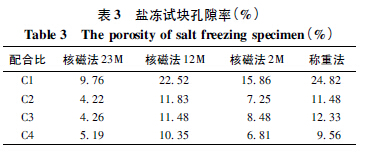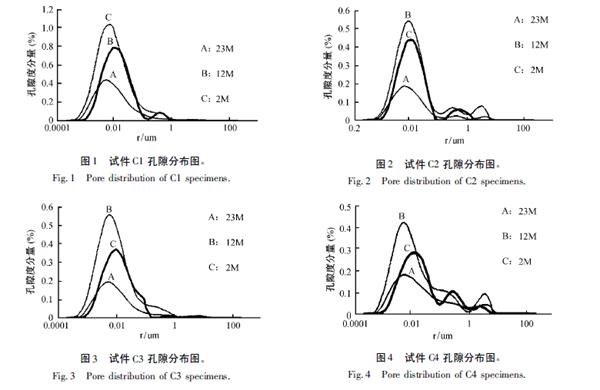Analysis of relationship between concrete porosity and salt-freezing by NMR data |
| The road concrete structure in the north area not only suffers from serious automobile overload problems, but also suffers from the freezing and thawing of spring and winter in this area, the large temperature difference between day and night, and the salt freezing caused by salting snow in winter. Therefore, cement concrete pavement and other concrete structures in this area are seriously damaged. However, research on high-performance concrete in highway construction in many areas in the north is still rare. |
| According to previous studies, the main factors affecting concrete frost resistance and salt freezing resistance include: gas content; water-cement ratio; saturated state of concrete; frozen age of concrete; cement variety and aggregate quality; influence of admixture . A large number of foreign experiments and field engineering practice results show that under the same conditions, the concrete durability or concrete service life using air entraining agent can be increased by more than 5 times.
Low magnetic field nuclear magnetic resonance analysis is a new technology for rapid measurement of cement and rock physical parameters in recent years. In nature, water is the most proton of hydrogen, and because the signal source of nuclear magnetic resonance is mainly hydrogen protons, the more hydrogen protons, the more moisture content, and vice versa. Therefore, by means of semaphore calibration, nuclear magnetic resonance techniques can be used to measure the quality of water in a substance.
After the porous medium is vacuum-saturated, most of the internal pores are occupied by water. By measuring the mass of water and the density of known water, the volume of pores in the porous medium can be calculated to obtain the porosity. This technology can study the changes in pore structure of different cement-based materials. |
| The porosity and pore distribution of the salt-free specimens (mixture ratios of C1, C2, C3, and C4) were tested by NMR methods using different magnetic field strengths. In order to compare the test results, the weighing method was also used to measure the porosity. |
| 
|
| The porosity measured on different nuclear magnetic strength devices is different. The porosity results were the highest measured by 12M equipment, the porosity of 23M equipment was the smallest, and the 2M equipment was centered. The reason for the smallest porosity results tested on the 23M equipment is that the mix of cement concrete samples incorporates fly ash, a paramagnetic ion-containing substance, and this part of the paramagnetic ion accelerates the relaxation of the entire sample. Yu, the relaxation of the sample is shortened, and the higher the field strength of the instrument itself, the more obvious its effect. |
| According to the results of the nuclear magnetic method porosity test, the sample pore size distribution map can be obtained, as shown in the following figure: |
| 
|
| As can be seen from the aperture map above, the amplitude of the signal on the 12M device is the largest and the amplitude of the signal on the 23M device is the smallest. The reason is also that the sample contains a certain amount of paramagnetic substance, which causes its relaxation to be accelerated at a relatively high field strength, so that the signal of some samples cannot be collected, so the higher the magnetic field, the smaller the signal amplitude.
The peak position of the data collected by the 2M device is obviously shifted to the right relative to the data collected by the 12M device. This is because the TE echo time on the 2M device is long, so that some valid signals at the initial time cannot be collected. In the case of concrete containing fly ash, the necessary improvements should be made to the 2M equipment. In summary, for short-relaxed cement concrete samples containing mineral admixtures such as fly ash, 12M equipment can effectively detect short relaxation signals and greatly improve signal-to-noise ratio. |
| References: "Analysis of Concrete Porosity and Salt Resistance by Nuclear Magnetic Resonance Data", Journal of Electron Microscopy, October 2015, Vol. 34, No. 5 |
|

